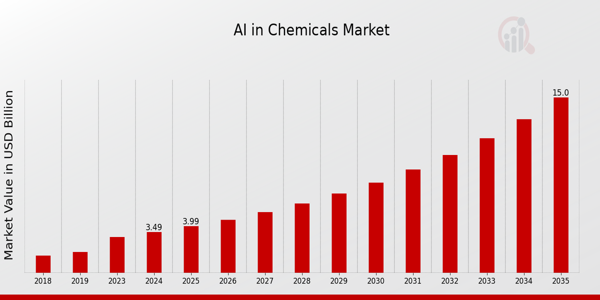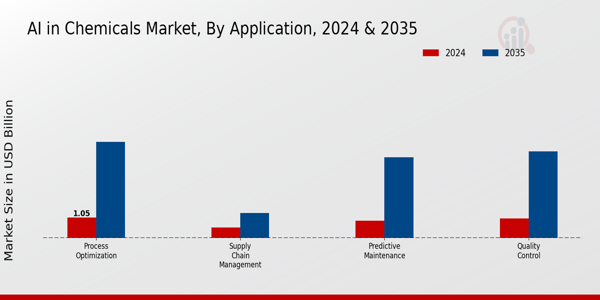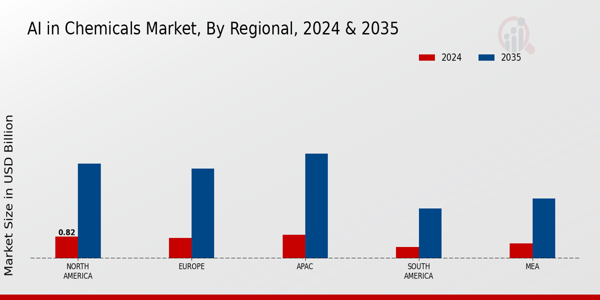AI in Chemicals Market Overview
As per MRFR analysis, the AI in Chemicals Market Size was estimated at 3.06 (USD Billion) in 2023. The AI in Chemicals Market Industry is expected to grow from 3.49 (USD Billion) in 2024 to 15 (USD Billion) by 2035. The AI in Chemicals Market CAGR (growth rate) is expected to be around 14.17% during the forecast period (2025 - 2035).
Key AI in Chemicals Market Trends Highlighted
The Global AI in Chemicals Market is witnessing several important trends that are shaping its future. A prominent market driver is the increasing push for digital transformation in the chemical industry. Companies are adopting AI technologies to enhance the efficiency of processes, improve product development, and minimize operational costs. This digital shift is largely driven by a need for more sustainable and environmentally friendly practices, as governments around the world emphasize the importance of sustainability in chemical production. The rise of data analytics and machine learning capabilities is also enabling organizations to make informed decisions, further driving the adoption of AI solutions.
Opportunities in the Global AI in Chemicals Market are abundant, particularly in the realm of predictive maintenance and supply chain optimization. By leveraging AI algorithms, companies can improve their predictive analytics capabilities, leading to reduced downtime and enhanced operational efficiency. Another significant opportunity lies in the development of smarter formulations and materials that respond dynamically to changing conditions, thus meeting the demands for more advanced applications across various sectors. Recent trends show a growing focus on collaboration between technology providers and chemical manufacturers. This collaboration is enhancing research and development efforts, leading to innovative solutions tailored to specific chemical applications.
Additionally, there is an increasing interest in integrating AI with other emerging technologies, such as the Internet of Things (IoT) and blockchain, creating synergies that can transform operations in the industry. Overall, the Global AI in the Chemicals Market is in a dynamic phase as stakeholders explore these trends and opportunities to foster growth and innovation.

Source: Primary Research, Secondary Research, MRFR Database and Analyst Review
AI in Chemicals Market Drivers
Rapid Advancements in Artificial Intelligence Technologies
The AI in Chemicals Market business is experiencing tremendous breakthroughs in artificial intelligence technologies that improve efficiency and productivity across a variety of chemical production processes. Improvements in machine learning, data analysis, and prediction algorithms fuel growth by allowing businesses to optimize operations, minimize waste, and improve product quality. According to the European Commission, investment in AI-related technologies has increased by more than 300 percent over the previous five years, generating enormous prospects for innovation in the chemical sector. As established companies such as BASF and Dow Chemical engage considerably in R&D to deploy AI solutions, the broader chemical sector is expected to profit significantly from this transformation, boosting the AI in Chemicals Market growth. This initiative promotes the use of AI in laboratories, production facilities, and supply chains, ultimately leading to increased operational efficiency and cost savings. Greater efficiency in the supply chain and manufacturing processes is projected to drive market expansion as top companies improve their competitiveness and adapt more effectively to consumer needs.
Increased Demand for Sustainable Practices
The push for sustainability in the Global AI in Chemicals Market industry is catalyzed by the growing consumer consciousness and regulatory pressures for environmentally friendly practices. Governments worldwide are setting ambitious sustainability targets; for instance, the United Nations has outlined goals for reduced carbon emissions that member countries aim to fulfill by 2030. As a result, chemical companies are adopting AI technologies to develop greener chemicals and streamline processes that minimize environmental impact.
Companies such as Henkel are leveraging AI to improve resource utilization and create eco-friendly products, leading to an anticipated annual growth rate in sustainable chemical production. The integration of AI in developing biodegradable materials and optimizing energy consumption not only meets regulatory requirements but also creates a more appealing product portfolio, attracting environmentally conscious consumers and fostering market growth.
Significant Investments in Research and Development
The Global AI in Chemicals Market industry is significantly bolstered by increased investments in Research and Development by major chemical companies. This trend is paramount for the ongoing development of AI applications in chemicals. Reports state that global spending on Research and Development across the chemicals sector has risen by approximately 10 percent year-on-year, reflecting a clear focus on enhancing capabilities through technological advancements.
Leading companies like ExxonMobil and DuPont are allocating substantial portions of their budgets toward AI-focused Research and Development, aiming to innovate in areas such as predictive maintenance, supply chain optimization, and product formulation. The financial commitment to R ensures that these organizations not only remain competitive but also lead in developing AI solutions tailored to the chemical industry. As innovation continues, the influx of advanced AI applications is expected to drive growth and expansion in the Global AI in Chemicals Market.
AI in Chemicals Market Segment Insights
AI in Chemicals Market Application Insights
The AI in Chemicals Market, with a focus on the Application segment, demonstrates notable growth dynamics, reflecting the increasing integration of artificial intelligence technologies in the chemical industry. In 2024, the overall market is valued at 3.49 USD Billion and is expected to grow significantly by 2035. The major applications within this domain include Process Optimization, Predictive Maintenance, Quality Control, and Supply Chain Management, each playing a vital role in enhancing operational efficiency and productivity.
Process Optimization stands out with a valuation of 1.05 USD Billion in 2024, growing to 5.0 USD Billion in 2035, thus dominating the market by providing real-time data analysis to streamline chemical processes and reduce waste. Predictive Maintenance, valued at 0.9 USD Billion in 2024 and forecasted to reach 4.2 USD Billion in 2035, leverages AI to anticipate equipment failures before they occur, thereby avoiding costly downtime and improving machinery lifespan. Quality Control, critical for meeting regulatory standards, is projected to rise from 1.0 USD Billion in 2024 to 4.5 USD Billion in 2035, ensuring product consistency and safety through advanced AI-driven inspection techniques.
Lastly, Supply Chain Management, which begins at a valuation of 0.54 USD Billion in 2024 and is expected to grow to 1.3 USD Billion in 2035, enhances inventory management and demand forecasting, allowing companies to respond quickly to market changes and reduce operating costs. Collectively, these applications underscore the significant impact of AI in transforming operational frameworks, driving growth and adaptability within the global chemical sector. The market growth is further fueled by advancements in AI technologies and the industry's ongoing quest to optimize processes, adhere to regulatory requirements, and enhance supply chain efficiency amidst evolving market demands and challenges.

Source: Primary Research, Secondary Research, MRFR Database and Analyst Review
AI in Chemicals Market Technology Insights
The AI in Chemicals Market is forecasted to reach a valuation of 3.49 USD Billion in 2024, demonstrating a robust trajectory for technology-driven solutions within this sector. The market is experiencing significant growth fueled by the increasing demand for automation and data-driven decision-making in the chemicals industry. Machine Learning plays a crucial role as it allows for predictive analytics that optimizes processes, leading to enhanced efficiency and reduced costs. Natural Language Processing facilitates better communication between systems and human operators, streamlining workflows and improving overall productivity.
Robotics Process Automation emerges as a vital mechanism for executing repetitive tasks, thereby freeing up human resources for more complex challenges. Additionally, Deep Learning contributes by offering advanced modeling capabilities, enhancing the ability to analyze vast datasets, which is essential for innovation in product development. The combination of these technologies forms a synergistic approach that is significantly transforming operations within the Global AI in Chemicals Market, ultimately contributing to the overall market growth anticipated to reach 15.0 USD Billion by 2035.
As these technologies continue to evolve, they present ample opportunities for companies looking to leverage artificial intelligence for improved operational efficiencies and strategic advantages.
AI in Chemicals Market End Use Industry Insights
The AI in Chemicals Market is poised for substantial growth, with a market valuation of 3.49 USD Billion expected in 2024. This growth is driven by increasing demand across various end use industries, particularly in sectors like Petrochemicals, Pharmaceuticals, Agricultural Chemicals, and Specialty Chemicals, where AI technologies are increasingly playing a pivotal role. The Pharmaceutical industry significantly benefits from AI through enhanced drug discovery and development processes, optimizing Research and Development pipelines, and reducing time to market.
Similarly, in Agricultural Chemicals, AI applications support precision farming and effective pest management, thus improving yield. The Petrochemical sector also leverages AI to optimize operations, enabling better resource management and operational efficiency. Furthermore, Specialty Chemicals are utilizing AI for innovative product development and customization to meet niche market demands. The ongoing digital transformation and the drive towards sustainability in the Global AI in Chemicals Market are critical factors shaping these industries, fostering innovation and creating lucrative opportunities for stakeholders.
Collectively, these end use industries represent a significant portion of the market's dynamics, influencing growth trajectories and enabling advancements in chemical manufacturing processes.
AI in Chemicals Market Deployment Type Insights
The AI in Chemicals Market has shown considerable growth, particularly in the Deployment Type segment, which plays a significant role in shaping industry dynamics. In 2024, the overall market is valued at 3.49 USD Billion, reflecting a robust interest in integrating artificial intelligence within the chemicals sector. Deployment types are generally categorized into three key areas: On-Premises, Cloud-Based, and Hybrid solutions. On-Premises systems, often preferred due to enhanced control over data and security, cater to organizations prioritizing stringent regulatory compliance.
Conversely, Cloud-Based solutions are gaining traction due to their scalability and flexibility, enabling companies to rapidly adapt to market changes without significant IT infrastructure investments. The Hybrid model, which combines both On-Premises and cloud functionalities, is increasingly popular as it allows organizations to tailor their deployment according to specific operational requirements. These deployment options together bolster efficiency, drive innovation, and expand capabilities, reflecting the diverse needs of organizations in the Global AI in Chemicals Market.
With demand surging, understanding these segments becomes crucial for stakeholders aiming to leverage AI technologies effectively within the chemical industry.
AI in Chemicals Market Regional Insights
The AI in Chemicals Market shows significant development across various regions, with a valuation of 3.49 USD Billion in 2024 and growing swiftly thereafter. In North America, the market is expected to be valued at 0.816 USD Billion in 2024 and grow to 3.562 USD Billion by 2035, indicating a robust demand driven by innovative technologies in chemical manufacturing and research initiatives. Europe is projected to be valued at 0.777 USD Billion in 2024 and reach 3.375 USD Billion in 2035, reflecting strong investments in sustainable practices and digital transformation.
The Asia-Pacific region, leading in growth potential, is anticipated to be valued at 0.894 USD Billion in 2024, with an increase to 3.938 USD Billion by 2035, fueled by rapid industrialization and a strong focus on smart manufacturing. South America, while smaller, is projected to expand from 0.428 USD Billion in 2024 to 1.875 USD Billion by 2035, showcasing emerging markets looking to adopt AI advancements. The Middle East and Africa, valued at 0.575 USD Billion in 2024, is expected to grow to 2.25 USD Billion by 2035, bolstered by enhanced oil and gas industry reliance on AI technologies.
Overall, the regional segmentation of the Global AI in Chemicals Market reveals diverse growth trajectories, highlighting areas where investment in AI can foster operational efficiency, sustainability, and innovation.

Source: Primary Research, Secondary Research, MRFR Database and Analyst Review
AI in Chemicals Market Key Players and Competitive Insights
The AI in Chemicals Market is witnessing tremendous growth driven by the increasing need for efficiency, innovation, and sustainability in the chemical industry. As companies strive to incorporate cutting-edge technologies, artificial intelligence has become a crucial component in optimizing processes, enhancing product development, and ensuring compliance with regulatory standards. Companies operating in this market are focusing on leveraging AI to analyze large datasets for insights, automate complex manufacturing processes, and enhance decision-making capabilities. The competitive landscape is evolving as prominent players invest heavily in research and development to create advanced AI solutions tailored for the chemical sector, leading to a rapidly changing environment where innovation and adaptability are key success factors.
IBM stands out in the Global AI in Chemicals Market for its robust technological expertise and commitment to research and development. The company has established a strong presence through its innovative AI platforms, which enable chemical manufacturers to harness the power of data analytics, machine learning, and cognitive computing. IBM’s strengths lie in its ability to provide end-to-end solutions that address specific challenges within the chemical industry, ranging from supply chain optimization to predictive maintenance and quality control. With a focus on collaboration, IBM partners with chemical companies to co-create AI-driven applications that enhance operational efficiency and bring new products to market faster. This strategic positioning not only strengthens IBM’s market presence but also solidifies its reputation as a thought leader in applying AI technologies within the chemicals sector.
SABIC is another key player in the Global AI in Chemicals Market, known for its diverse portfolio of chemical products and commitment to innovation. The company focuses on developing solutions that leverage AI to improve production efficiency and product quality while minimizing environmental impact. SABIC has implemented several AI-driven initiatives aimed at optimizing manufacturing processes and enhancing supply chain management. The company’s strengths lie in its comprehensive understanding of the chemical landscape and its ability to integrate AI technologies into existing operations. Additionally, SABIC has pursued strategic partnerships and mergers to enhance its capabilities in AI and innovation, significantly broadening its market reach. Through these efforts, SABIC continues to improve its offerings, ensuring a competitive edge in a rapidly evolving global market.
Key Companies in the AI in Chemicals Market Include
- IBM
- SABIC
- NVIDIA
- SAP
- Accenture
- Cargill
- Covestro
- Google
- Aspen Technology
- Microsoft
- Dow
- BASF
- Honeywell
- Siemens
AI in Chemicals Market Industry Developments
Recent developments in the AI in Chemicals Market indicate a significant shift towards increased integration of artificial intelligence technologies within chemical manufacturing processes. Notable players such as IBM, NVIDIA, and BASF are harnessing AI to enhance product development and process optimization, thus driving operational efficiencies and innovation. In terms of mergers and acquisitions, in August 2023, Microsoft acquired a data analytics firm specializing in AI solutions for the chemicals industry, aiming to bolster its AI capabilities in this sector. Additionally, Accenture has been expanding its portfolio by partnering with Cargill to leverage AI in food production and supply chain management.
The market's valuation is experiencing growth, influenced by advancements in AI technologies, which are projected to streamline production processes and improve predictive maintenance, ultimately impacting profitability positively. Over the past few years, from 2021 to 2023, companies like Honeywell and Siemens have also made strides by investing heavily in AI Research and Development initiatives focused on sustainability in chemicals. This trend reflects a broader commitment across the Global industry to embrace technological innovations for achieving greener and more efficient chemical production.
AI in Chemicals Market Segmentation Insights
-
AI in Chemicals Market Application Outlook
-
Process Optimization
-
Predictive Maintenance
-
Quality Control
-
Supply Chain Management
-
AI in Chemicals Market Technology Outlook
-
AI in Chemicals Market End Use Industry Outlook
-
Petrochemical
-
Pharmaceutical
-
Agricultural Chemicals
-
Specialty Chemicals
-
AI in Chemicals Market Deployment Type Outlook
-
On-Premises
-
Cloud-Based
-
Hybrid
-
AI in Chemicals Market Regional Outlook
-
North America
-
Europe
-
South America
-
Asia Pacific
-
Middle East and Africa
AI in Chemicals Market Report Scope
|
Report Attribute/Metric
|
Details
|
|
Market Size 2023
|
3.06(USD Billion)
|
|
Market Size 2024
|
3.49(USD Billion)
|
|
Market Size 2035
|
15.0(USD Billion)
|
|
Compound Annual Growth Rate (CAGR)
|
14.17% (2025 - 2035)
|
|
Report Coverage
|
Revenue Forecast, Competitive Landscape, Growth Factors, and Trends
|
|
Base Year
|
2024
|
|
Market Forecast Period
|
2025 - 2035
|
|
Historical Data
|
2019 - 2024
|
|
Market Forecast Units
|
USD Billion
|
|
Key Companies Profiled
|
IBM, SABIC, NVIDIA, SAP, Accenture, Cargill, Covestro, Google, Aspen Technology, Microsoft, Dow, BASF, Honeywell, Siemens
|
|
Segments Covered
|
Application, Technology, End Use Industry, Deployment Type, Regional
|
|
Key Market Opportunities
|
Predictive maintenance solutions, Supply chain optimization tools, Enhanced R processes, Sustainable chemical production, Real-time quality monitoring systems
|
|
Key Market Dynamics
|
Increasing R investment, Demand for efficiency, Regulatory compliance pressures, Adoption of smart technologies, Sustainability initiatives
|
|
Countries Covered
|
North America, Europe, APAC, South America, MEA
|
Frequently Asked Questions (FAQ) :
The Global AI in Chemicals Market is expected to be valued at 3.49 USD Billion by the year 2024.
By 2035, the Global AI in Chemicals Market is projected to reach a value of 15.0 USD Billion.
The Global AI in Chemicals Market is anticipated to grow at a CAGR of 14.17% from 2025 to 2035.
North America is projected to dominate the Global AI in Chemicals Market with a value of 3.562 USD Billion by 2035.
The market value for Process Optimization in the Global AI in Chemicals Market is expected to reach 5.0 USD Billion by 2035.
The expected market size for Predictive Maintenance in the Global AI in Chemicals Market is 0.9 USD Billion in 2024.
Major players in the Global AI in Chemicals Market include IBM, SABIC, NVIDIA, SAP, and Accenture.
The market value for Quality Control in the Global AI in Chemicals Market is anticipated to be 4.5 USD Billion by 2035.
The expected market value for Supply Chain Management in 2024 is 0.54 USD Billion.
APAC is expected to experience significant growth, with a market value of 3.938 USD Billion by 2035.

















